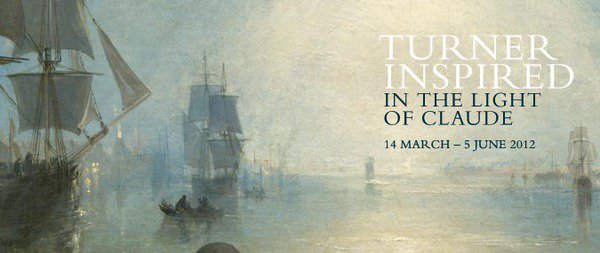Turner Inspired
dal 12/3/2012 al 4/6/2012
Segnalato da
12/3/2012
Turner Inspired
The National Gallery, London
Turner created a revolution in painting at the beginning of the 19th century, responding to a modern industrial landscape with a freer style and new approaches to composition. Yet a lasting dialogue with the 17th century painter Claude lay at the heart of these developments.This exhibition offers the chance to compare closely related works by Turner and Claude and discover the extent to which Turner was inspired by Claude's mastery of light and landscape.

The National Gallery’s spring exhibition, Turner Inspired: In the Light of Claude, is the first major presentation of Claude’s influence on Turner. Turner’s daring free painting technique and radical approach created a revolution in painting at the beginning of the 19th century. The inspiration for these dramatic developments was the 17th-century artist Claude’s mastery of light on canvas. This exhibition tells the story behind Turner’s inspiration and the revolutionary works that went on to inspire future generations of artists.
The show reveals how Turner’s life-long desire to absorb all he could from the Old Master lay at the heart of his work. From the Roman Campagna-inspired views of the Thames Valley to paintings of the emerging industrial landscape, 'Keelmen Heaving in Coals by Night' (1835, National Gallery of Art, Washington), the exhibition demonstrates Turner’s skill at recreating gleaming light and atmosphere.
Turner’s first experience of the work of Claude had an immediate and lasting impact on the artist. A contemporary remarked that, ‘Turner was awkward, agitated and burst into tears’ on seeing Seaport with the Embarkation of the Queen of Sheba (1648, The National Gallery). The combination of natural detail and ethereal effect in masterpieces such as 'Landscape with the Arrival of Aeneas before the City of Pallenteum' (1675, National Trust’s Anglesey Abbey) proved irresistible. He was captivated with Claude’s ability to depict light in landscape and praised his work as ‘pure as Italian air’.
The exhibition focuses on the major Claude-inspired themes that run through Turner’s career and that on occasion shocked and dazzled audiences of his day: the evocation of light and air in landscape, the effect of light upon water and his often radical reworking of contemporary scenes. The exhibition brings together a rich variety of media such as large majestic oils on canvas, mezzotints, etchings, watercolours and works in gouache, and displays of leaves from Turner’s pocket sketchbooks that show intimate drawings in pen, pencil and ink on paper, rarely on public display.
The importance of the sea to Britain’s identity is another crucial theme of Turner’s work and Claude’s harbour scenes exerted a powerful hold on his imagination, as shown in works including 'Le Havre: Sunset in the Port', (about 1832, Tate) and East Cowes, the Seat of J. Nash, Esq. (about 1827–30, Victoria and Albert Museum). The exhibition includes a selection of Turner’s most spectacular watercolours from the 1840s which depict the unique character of Venetian light.
On his death – and linking himself to Claude for posterity – Turner left the National Gallery Dido building Carthage (1815) and Sun rising through Vapour: Fishermen cleaning and selling Fish (before 1807) on condition that they were hung between two pictures by Claude, which he named as ‘The Seaport’ (Seaport with the Embarkation of the Queen of Sheba, 1648) and ‘The Mill’ (Landscape with the Marriage of Isaac and Rebecca, 1648). The exhibition sheds light on this relationship through photographs, letters and works that tell the story behind the Turner Bequest and its importance in the history of the National Gallery.
'Turner Inspired: In the Light of Claude' unites works from Tate, The Holkham Estate and art galleries and museums around the United Kingdom including Glasgow Museums, Walker Art Gallery Liverpool and Sheffield Galleries and Museums Trust, as well as works from the United States. The exhibition has been organised in collaboration with Tate Britain. It has been conceived, and works have been selected, by Ian Warrell, Curator of 18th- and 19th-Century British Art at Tate Britain and known internationally as a leading expert on the subject. The National Gallery curator is Susan Foister.
For further press information please contact Lizzie Phillips at lizzie.phillips@ng-london.org.uk / 020 7747 2532
Press view: 13 March 2012 (10.30am–1.30pm)
National Gallery
Trafalgar Square - London
Hours: Daily 10am–6pm (last admission 5.15pm)
Late nights Fridays until 9pm (last admission 8.15pm)



